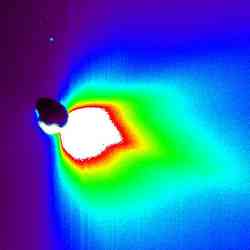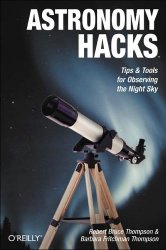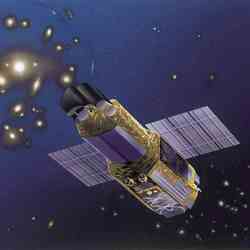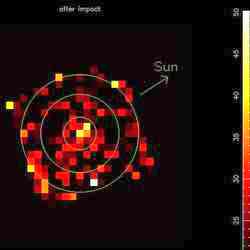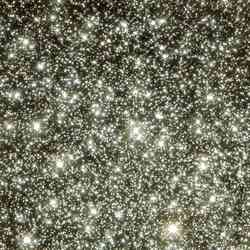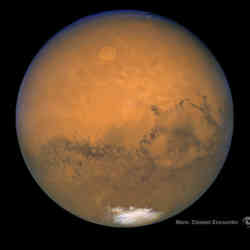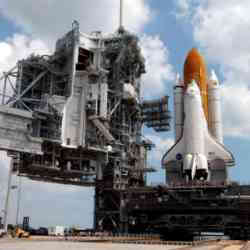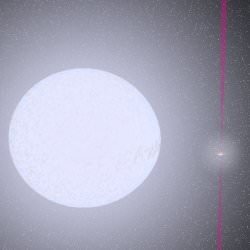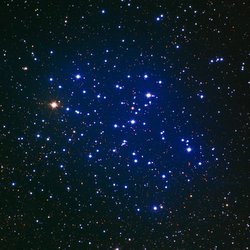
Star cluster Epsilon Scorpii (M6). Image credit: N.A. Sharp and Mark Hanna, REU Program/NOAO/AURA/NSF. Click to enlarge.
Monday, July 11 – For viewers in west Europe and northwest Africa, you will have the opportunity to watch the Moon occult 4th magnitude Sigma Leonis on this universal date. Please check the IOTA webpage for precise times in your location.
Tonight on the lunar surface, aim your binoculars or telescope towards the south shore of Mare Nectaris where we will examine ruined crater Fracastorius. To lower power, this will be a delicate, almost bay-like feature softly outlined in white. This is all that remains of a once-great crater as the lava flow from the mare filled it in. To its southern edge, the old walls still rise, but much of the north border is completely obliterated. If you examine it telescopically, you will see that the north has been reduced to a low series of ridges and craterlets, yet in binoculars it still gives the illusion of a complete ring.
As the Moon sets and the constellation of Scorpius rises higher, tonight would be an ideal time to look at a brilliant open cluster about a fist width east of Epsilon Scorpii – M6. On a moonless night, the 50 or so members of this 2000 light year distant, 100 million year old cluster can usually be seen unaided as a small fuzzy patch just above the Scorpion’s tail. Tonight we visit because the brighter skies will aid you in seeing the primary stars distinctive asterism. Using binoculars or telescope at lowest power, the outline of stars does truly resemble its namesake – the “Butterfly Cluster”. The M6 is much more than “just a pretty face” and we’ll be back to study under darker skies.
Tuesday, July 12 – Watch the quick progress of Mercury as it cruises beneath Venus over the next two nights starting about 45 minutes after sunset. Venus will be quite low at about half a fist width above the west/northwest horizon, and you will probably need binoculars to spot Mercury another 3 degrees lower. Be sure to note the position of Regulus, a little more than a fist width above and to the left of Venus.
With the anniversary of the Apollo 11 moon landing only eight days away, tonight will be our opportunity to look at the landing site on the lunar surface. To the unaided eye, look almost central on the lunar disc for the grey oval of Mare Tranquillitatus. Near the terminator you will note a brightness where the shore curves around the south edge to join Mare Nectaris. By aiming binoculars at this area, you can distinguish the bright peninsula just north of the three rings of Theophilus, Cyrillus and Catherina. To the telescope at mid-to-high power, note shallow rings of craters Sabine and Ritter to the northwest of this bright area. If you have a steady night on your hands – step up the power to maximum. East of Sabine and Ritter are three tiny craters in the otherwise smooth surface. From west to east they are Aldrin, Collins and Armstrong – the only craters on the Moon named for the living. Just south of Collins is the actual landing site and we salute the crew of Apollo 11 by viewing tonight just shy of 36 years since their adventure.
Wednesday, July 13 – Tonight lucky viewers for almost all of South America will have the chance to witness a spectacular occultation of Jupiter by the Moon. You can find precise times for your location on this IOTA webpage. Even if you do not use a telescope, I strongly urge you to at least watch this event! For viewers in New Zealand, you will have the opportunity to watch the Moon occult Eta Virginis. The precise times for a city near you are listed on this IOTA webpage.
For most of us, Jupiter and the Moon will make a very pleasing pair tonight. but let’s venture to a deep impact crater on the Moon. You will find Manilius telescopically just north of center along the terminator on the eastern shore Mare Vaporum. While it doesn’t appear to be much more than a singular “hole” on the lunar surface, Manilius is incredibly deep. Spanning around 39 km (25 miles), this crater drops down 3010 meters (9500 feet) below the Moon’s topography. That’s about 2/3 the distance that Titanic lay beneath the ocean!
Thursday, July 14 – Forty years ago today, Mariner 4 performed the first flyby of Mars. If you’re up before dawn this morning, be sure to look for the “Red Planet” as it cruises through Pices and heads toward the Sun.
Tonight the star accompanying the Moon on the right is Spica, but let’s explore the lunar surface in hopes of catching an unusual event. On the southern edge of the Mare Nubium is the old walled plain Pitatus. Power up. On the western edge you will see smaller and equally old Hesiodus, sharing a common wall. Almost central along this wall there is a break to watch when the terminator is close. For a brief moment, sunrise on the Moon will pass through this break creating a beam of light across the crater floor known as the Hesiodus Sunrise Ray. If the terminator has moved beyond it at your observing time, look to the south for small Hesiodus A. This is an example of an extremely rare double concentric crater. This formation is caused by an impact being followed by another, slightly smaller impact on exactly the same location.
Friday, July 15 – For our friends in Australia comes one incredible event… Tonight the Moon will occult Comet 9/P Tempel 1. For more information on this event, please visit the IOTA webpages for times and locations. We wish you the very best of skies!
For the rest of us, we’re stuck with the Moon, but this is a great chance to explore under-rated crater Bullialdus. Once again, we’re in the southern quadrant of the Moon near the terminator. Even binoculars can make out this crater with ease near the center of Mare Nubium. If you’re scoping – power up – this one is fun! Very similar to Copernicus, note Bullialdus’ thick, terraced walls and central peak. If you examine the area around it carefully, you can note it is a much newer crater than shallow Lubiniezsky to its north and almost non-existant Kies to the south. On Bullialdus southern flank, it’s easy to make out both its A and B craters, as well as the interesting little Koenig to the southwest.
Saturday, July 16 – Today in 1850 at Harvard University, the first photograph of a star was made (other than the Sun). The honors went to Vega! In 1994, an impact event was about to happen as nearly two dozen fragments of Comet Shoemaker-Levy 9 were speeding their way to the surface of Jupiter. The result was spectacular and the visible features left behind on the planet’s atmosphere were the finest ever recorded. Why not take the time to look a Jupiter again tonight while it still holds good sky position? No matter where you observe from, this constantly changing planet offers a wealth of things to look at – be it the appearance of the “Great Red Spot”, or just the ever changing waltz of the galiean moons.
Tonight no feature on the Moon will be more prominent that the Sinus Iridium, but if you have steady skies, why not power up to look a some of the finer features such as Bianchinni and Sharp on its borders? It the night is exceptionally steady, you may see up to a half dozen very small craters within the “bay” itself. Just outside in Mare Ibrium, even modest power can make out Helicon and Le Verrier. If the Dorsum Heim captures your imagination, look for tiny C. Herschel in its center.
Sunday, July 17 – Today in 1963, the Nuclear Test Ban Treaty is signed. This treaty prohibits the detonation of nuclear devices in our atmosphere. To be sure all countries were in compliance, the United States afterward launched the first gamma ray detectors into orbit. In 1967 these detectors picked up a new discovery – the first of many cosmic gamma ray sources.
Observers located along a path that includes Mexico, Central America, northern South America, and the extreme southern and western U.S. have the opportunity to witness the occultation of Antares tonight, while most of the U.S. will see the Moon graze just south. For times of the event at selected cities, see this page or Dr. David Dunham’s personal webpages which includes graze information. For central South America viewers and lower California, you will also be treated to the occulation of Sigma Scorpii on the universal date. Check IOTA wepages for more details. Clear skies!
If you chose to view the lunar surface, be sure to look for crater Schiller near the terminator on the southern cusp. Its long oval form is a real treat.
Yes, the Moon is back, but I’ll do my best to find more great events to enjoy! May all your journeys be at Light Speed… ~Tammy Plotner
